a potential vaccine delivery mechanism. Researchers demonstrated in animal models that dental floss could effectively release vaccines through the tissue between teeth and gums. This method triggered the production of antibodies in mucosal surfaces, such as the lining of the nose and lungs.
The study's findings, published in Nature Biomedical Engineering, highlight the importance of mucosal surfaces as entry points for pathogens like influenza and COVID. Unlike traditional injection methods that primarily stimulate antibody production in the bloodstream, delivering vaccines via mucosal surfaces enhances the body's ability to prevent infection by providing an additional line of defense.
The vaccine enters through the junctional epithelium, a thin tissue layer in the deep pocket between the tooth and gum. This tissue's unique properties allow for the release of immune cells into the body. Researchers added a peptide flu vaccine to unwaxed dental floss and used it to floss the teeth of lab mice.
The effectiveness of the floss-delivered vaccine was compared to nasal and oral delivery methods. The flossing technique produced a superior antibody response on mucosal surfaces compared to the current standard for oral vaccination. It also provided comparable protection against the flu virus as nasal administration. The test was repeated for various vaccine types, including proteins, inactivated viruses, and mRNA, with the flossing technique consistently producing robust antibody responses.
The research team plans to test the effectiveness of vaccine delivery to the epithelial junction in humans using floss picks. This method could be easy to administer and address concerns about needle-based vaccinations.
While the study presents promising results, there are limitations. The technique wouldn't be applicable to individuals without teeth, such as babies and toddlers. Further research is needed to understand its effectiveness in people with gum disease or other oral infections. Additional questions remain regarding the exact path of vaccine components and the generation of immune responses. The efficacy of floss-based vaccines must also be comparable to conventional needle-based vaccines.







1 Comments
Karamba
This research is promising, but let's be honest – the thought of being flossing for a vaccine makes me cringe.